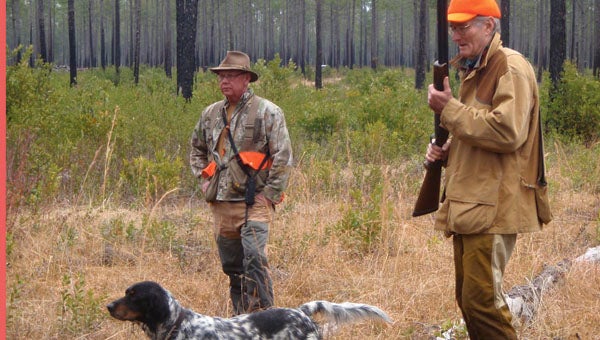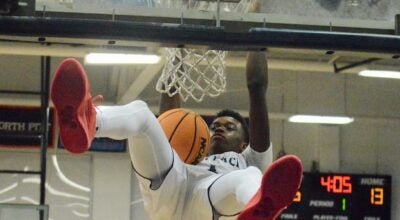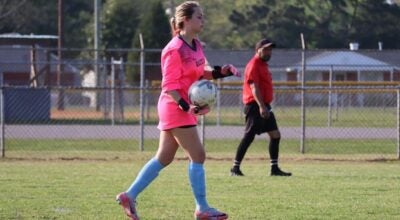Bobwhite quail on the rise?
Published 5:00 pm Tuesday, December 10, 2013

Guy Tripp closes in on what he hopes is a good covey of quail that his dog, Brandon, has pointed. The guide, Ken, stands by in the background.
By Fred Bonner
I don’t know of any quail hunters who aren’t distresses with the lack of their treasured “Bobwhites” these days. Whether the alarming decline of the birds is due to over hunting, large numbers of predators, lack of suitable habitat, pesticides or global warming or a combination of all of the above, the facts are that it’s rare to see large coveys of quail anymore.
That’s why I was nearly scared silly a few days ago when I got out of my car beside a small patch of woods and from under my feet more quail than I’ve seen in many days burst from the scant cover. I stood there in awe as my young dog that had never experienced such a sight or sound went nuts trying to see what had made that noise. I estimated that there were about two dozen birds in that covey and, since nobody had been releasing pen-raised birds in that area, these had to be wild birds.
In spite of the fact that I’d have loved nothing better than to have been standing with my shotgun at the ready when that big covey burst from cover, I hope nobody bothers that covey for a year or two. We desperately need some good broods of truly wild quail on hand to reproduce enough young quail that can move on into what little good cover is around for the birds to live in.
That same little patch of woods was once surrounded in agricultural fields that produced enough crops that left a small percentage of the grain that was harvested to feed the five coveys that used to call this area home. It was in this little woods that I learned to quail hunt.
A friend of my father had given me an old N.R. Davis & Sons double barreled, 12-gauge shotgun that had been sawed off to what bird hunters liked for this type of close cover quail hunting. I knew that woods like the back of my hand and would ride my bike over to the farm on Saturday mornings and could, even without having a bird dog, depend on jumping two or three coveys of quail on a good day. Those days are gone but not forgotten.
The farmlands that once surrounded those woods had ditch banks grown up in brush that offered the birds cover as they searched for food in the fields. The quail could scurry from their nighttime resting place in the thick woods, into the fields to feed and still have a relatively safe bit of cover in the ditch banks if a predator threatened.
Today the ditches hold little (if any) cover at all for quail or rabbits. Any quail, rabbit or other small animal that dared to go into the field to feed would attract the immediate attention of predators such as hawks, foxes or coyotes.
Modern farming methods can produce very high yields of grain crops and modern harvesting methods usually leave little in the fields for wildlife to feed on. You can’t totally blame the farmers though. They tend to use every square inch of tillable land to grow crops that are planted up to the very edge of the drainage ditches.
Some blame the decline in the population of quail on the use of pesticides that control the insects that quail like to feed on but quail are highly adaptable and can feed on native grains and seeds that aren’t produced by agriculture. I once spent a summer and fall analyzing the crop contents of bobwhite quail that had been taken from public hunting grounds that the North Carolina Wildlife Resources Commission manages in the sand hills area of our state. Most of these game lands were pine forest and broom sage with plenty of brush mixed in. I found little in the way of food that agriculture produced in those quail crops.
What impressed me the most was the diversity of the things that bobwhite quail fed on. I found acorns that seemed to be too big for a quail to swallow but here was the evidence that they had eaten them. Numerous native grains, nuts and berries were in the crops. Numerous insects were found and ants played a large part in the insects found in the crops. In the final analysis after month’s of study of the foods quail fed on was (surprise!) the abundance of poison ivy seeds in the quail crops.
About ten years ago I had the pleasure of hunting bobwhites on a large farm in Hyde County. The landowner was carefully managing the farm for wildlife in addition to farming crops such as wheat, corn and soybeans. To enhance the wildlife populations on his farm he was using textbook methods to benefit the wildlife and this included windrows along ditch banks for small game cover. He hired trappers to help control the predators and carefully monitored the numbers of quail that were harvested by hunters.
There was always enough brood stock left in the coveys of quail that survived after the hunting season. Other landowners of large tracts of land in that area managed their wildlife in a similar manner. In spite of what seemed to be the near perfect management of these farms for bobwhite quail production, their quail populations have declined nearly as dramatically as the ones that didn’t manage as closely.
It was once thought that landowners could boost their quail populations through stocking pen-raised birds into a somewhat protected area. Research into the survival rates for these pen-raised birds showed that something like 99% of these birds would not survive on their own. On the other hand there has been a good amount of success with boosting quail populations by trapping either part or entire coveys of wild quail and releasing these as a closely-knit group into good habitat areas in want of bobwhite quail. The flocking characteristics of the truly wild birds seemed to give these relocated birds the protection they needed in order to live and reproduce in the managed areas.
I hope that that big covey of bobwhites that I flushed a week or so ago was not an isolated incident. If that could be an indication that the quail populations are indeed increasing even slightly, there’s still hope that next spring we’ll again hear several coveys sounding off with their characteristic “bob-bob-white” mating call.
Wildlife managers, hunters and bird watchers alike will rejoice in seeing the native populations of truly wild birds restored to what their levels used to be. Joint efforts to accomplish these goals between private landowners, state and federal wildlife management teams, and private conservation groups such as Quail Unlimited, Quail Forever and research groups such the as the Tall Timbers Research Station and National Bobwhite Conservation Initiative will play important roles in restoring the bobwhite quail to acceptable levels.





